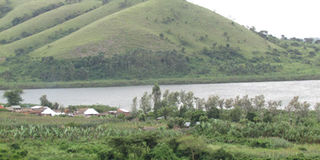Encroachers defy Museveni directive on vacating wetlands

Wetlands. A section of Katete Landing Site on the shores of Lake Kacheera. National Environment Management Authority planted trees to conserve the environment. PHOTO BY PAUL SSEKANDI
What you need to know:
Encroachers. Mr Charles Saturday, the Kacheera Sub-county agriculture officer, says encroachers usually operate in the night.
Encroachers occupying wetlands around Lake Kacheera have continued to practise farming despite President Museveni’s directive to stop all activities in the area.
Lake Kacheera is a major water source for communities in Lyantonde, Rakai, Isingiro and Kiruhura districts.
Its tributaries connect to both Lake Kijjanebarora and River Kagera.
During his wealth creation tour in Lyantonde District in July last year, President Museveni said: “All those people who are planting maize and cabbages in the swamps around Lake Kacheera should stop with immediate effect. They are destroying the environment and very soon what we are planning in the agriculture sector will also fail due to their actions.”
However, a visit to the lake at the weekend revealed that people took more land for agriculture.
Mr Charles Saturday, the Kacheera Sub-county agriculture officer, said encroachers usually operate in the night.
To be affected
He said if the presidential directive is to be implemented, more than 40,000 residents would be affected.
“I’m aware of the presidential directive, but at my level, I lack powers to enforce such a directive,” he said.
In addition to planting crops such as coco yams, Irish potatoes, maize, beans and tomatoes, among other crops, the encroachers are also planting eucalyptus trees.
“All waterlogged areas have dried up and what is remaining is only the lake,” Mr Saturday said.
He added: “Most of the wild pigs and hippopotamuses that have been displaced from their habitats are now terrorising neigbouring villages and people have lost lives and property.”
Mr Don Wanyama, the senior presidential press secretary, has on several occasions said the presidential directives are supposed to be implemented by line ministries and agencies.
“He has done his part of preaching the dangers of wetland encroachment and offering guidance,” Mr Wanyama said recently.
Buyamba County Member of Parliament Amos Mandela told Daily Monitor that encroachers have been using the wetland for many years and evicting them will render them jobless.
He said they have started sensitising locals through Rwizi Catchment Management Organisation on how to manage the environment.
“I have so far mobilised 200 youth that are yet to be trained in aquaculture to start fish farming. This will boost people’s livelihoods without affecting the environment,’’ Mr Mandela said.
He said interventions are also underway to boost sustainable use of wetlands, adding that he has mobilised residents to plant trees near landing sites to prevent soil erosion.
Mr Benon Kyangabire, a fish farmer in Kibaati Trading Centre, Kacheera Sub-county, appealed to government to offer them fish farming skills so that they can have an alternative source of income.
“People are encroaching on the wetlands simply because they lack sustainable source of income,” he said.
Mr Augustine Kalinda, a resident of Kateete Landing Site, said he has been using the wetland for crop growing since 1971.
“I have used this wetland for the last 48 years, the National Environmental Management Authority (Nema) has issued several warnings, but I have nowhere to go. I ask the President to guide us on how best we can use the wetland than just evicting us,’’ Mr Kalinda said.
Wetlands in Uganda
Coverage. Wetlands in Uganda cover less than 10 per cent of Uganda’s land surface area, however, these wetlands have been on a downward slide from 15. 6 per cent in 1994 to 10.3 per cent in 2015.
Degradation. Wetland degradation has devastated the potential of storing water and filtering pollutants. This has caused natural calamities such as floods, pollution of water bodies on Lake Wamala, Lake Kyoga and Lake Victoria hence declining fish stocks.
Law. Section 36 of the National Environment Act provides for the protection of wetlands and prohibits reclamation, erection of illegal structures and empowers authorities to demolish any structure that is fixed at any wetland. The Act also empowers districts to manage wetlands within their jurisdictions and ensure that their boundaries are clearly demarcated.


